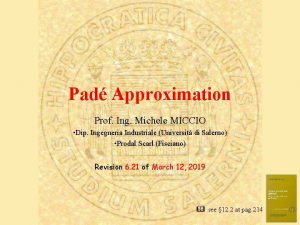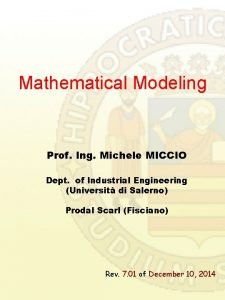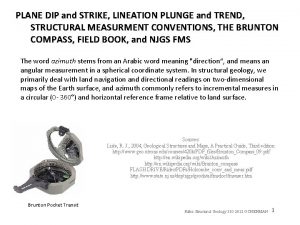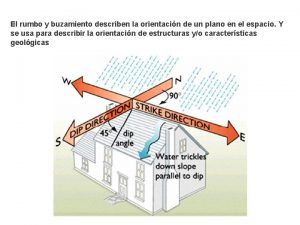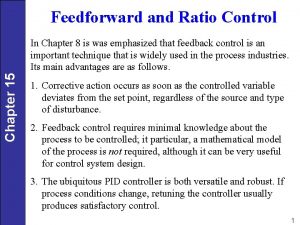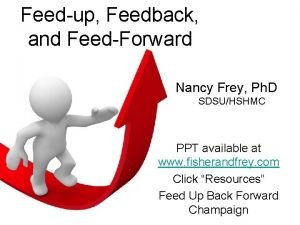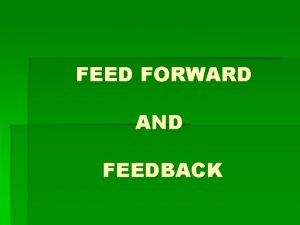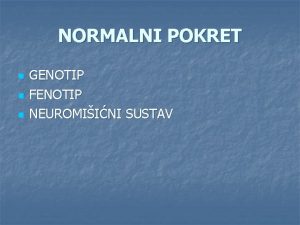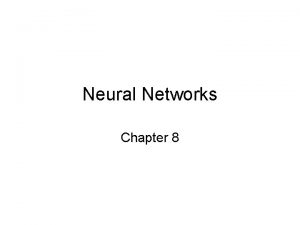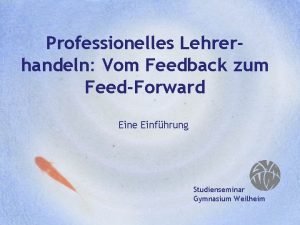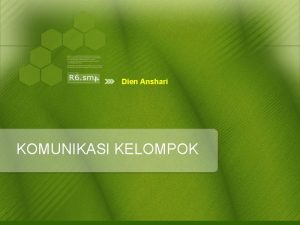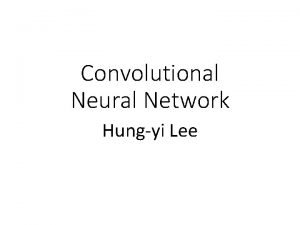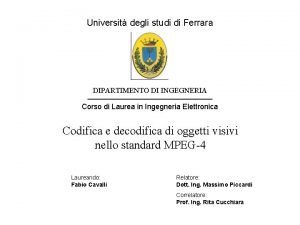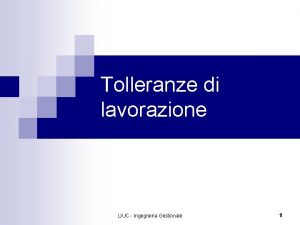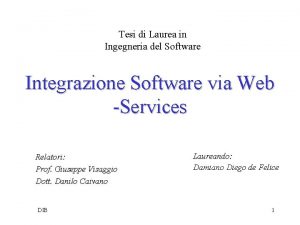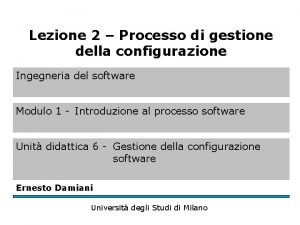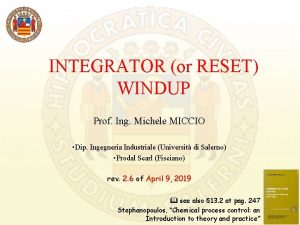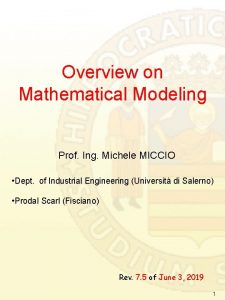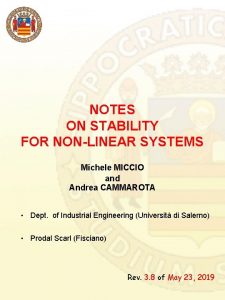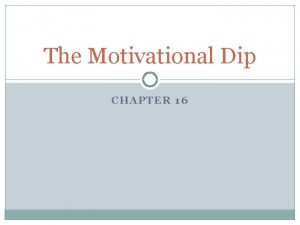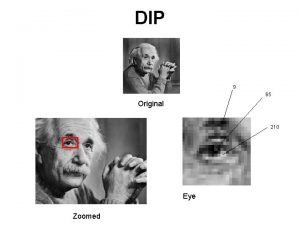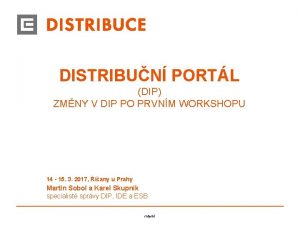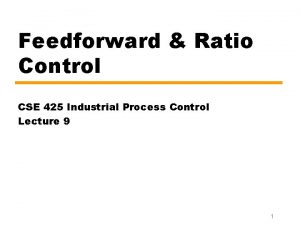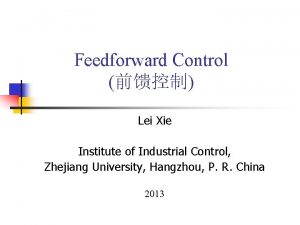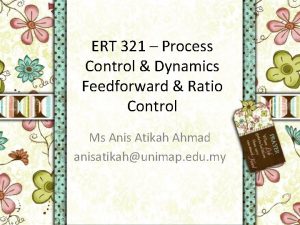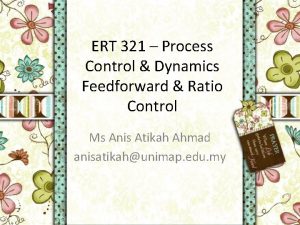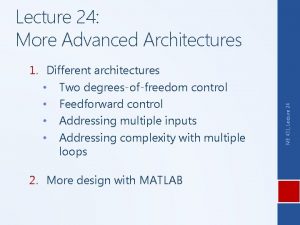Feedforward Control Prof Ing Michele MICCIO Dip Ingegneria
















- Slides: 16

Feedforward Control Prof. Ing. Michele MICCIO Dip. Ingegneria Industriale (Università di Salerno) o Prodal Scarl (Fisciano) o adapted from Romagnoli & Palazoglu’s Chapter 16: Model-Based Control see also Stephanopoulos, 1984 Chapter 21 § 21. 1 -4 rev. 3. 4 of April 30, 2019

Introduction to Model-Based Control In this course we consider the following control design techniques that explicitly use the process model: Ø Ø Delay Compensation (Smith Predictor) Inverse Response Compensation Feedforward control Model Predictive Control (MPC) Romagnoli & Palazoglu, “Introduction to Process Control “ 2

Introduction to Model-Based Control Definition of Model-Based Control Detailed Process Understanding Combination of detailed process understanding (advanced mathematical modeling) with the intelligent use of modern control systems (hardware, software and technology). Romagnoli & Palazoglu, “Introduction to Process Control “ Intelligent Use of Modern Control Systems Improved Profitability $ 3

Back to Feedback Control Ø Feedback control can never achieve perfect control of a chemical process. It reacts to the changes in the controlled variable after a deviation is detected in the output. Disturbance Set-point Controller Manipulated variable Process Controlled variable Sensor Romagnoli & Palazoglu, “Introduction to Process Control “ 4

Feedforward Control Ø A feedforward controller measures the disturbance directly and takes control action to compensate for its eventual impact on the output variable. Ø Feedforward controllers have theoretical potential for perfect control. Romagnoli & Palazoglu, “Introduction to Process Control “ 5

Feedforward Control Consider the following feedforward flow of information about disturbance … Disturbance Set point Controller output Feedforward Controller Final control element Manipulated variable Process Controlled variable the feedforward controller predicts the effect of disturbances Romagnoli & Palazoglu, “Introduction to Process Control “ 6

Feedforward Control Design We want to achieve the following control Therefore, in the Laplace domain: objective: y(t) = ysp(t) d(s) gd(s) Process m(s) gp(s) y(s) 1 We shall require perfect control : Romagnoli & Palazoglu, “Introduction to Process Control “ 7

Feedforward Control Design We introduce a suitable structure for the feedforward controller. Then, we further determine m(s) from the block algebra: 2 y sp g 1 ff disturbance measurement + − g md process vs. disturbance gd g 2 ff actual feedforward controller 3 d o g m f final control element g + + y p process Romagnoli & Palazoglu, “Introduction to Process Control “ 8

Feedforward Control Ø The feedforward control elements conventional controllers (P, PI or PID) are not Ø The feedforward controller: § needs the gff 1 block in order to make the set point comparable to the measured disturbance § depends on the knowledge of process and disturbance models § can be developed for more than one disturbance and for multiple controlled variables Romagnoli & Palazoglu, “Introduction to Process Control “ 9

Feedforward vs Feedback Feedforward - Advantages Ø Ø Ø Acts before disturbances affect the process Cannot cause instability Good for slow process dynamics Feedforward - Disadvantages Ø Ø Ø Must identify and measure ALL disturbances Fails for unmeasured disturbances Needs to have a reliable process dynamic model Fails for changes within the process No indication of control quality Romagnoli & Palazoglu, “Introduction to Process Control “ 10

Feedforward vs Feedback - Advantages Ø No disturbance measurements needed Ø Limited or even no process model needed Ø Can cope with changes within process Feedback - Disadvantages Ø Will always be some error Ø Poor for slow process dynamics, interaction, etc. Ø Instability is possible Romagnoli & Palazoglu, “Introduction to Process Control “ 11

Feedforward-Feedback Control Use a combination of Feedforward and Feedback control We expect that a combined feedforward-feedback control system will retain, The superior performance of a feedforward controller, and v The insensitivity of the feedback controller to uncertainties in model and inaccuracies in model parameters. v Romagnoli & Palazoglu, “Introduction to Process Control “ 12

Example 1: Process with dead time Consider the following process TFs: gmd and gf purely algebraic Ø Design a Feedforward Controller Ø Compare with PI feedback design Romagnoli & Palazoglu, “Introduction to Process Control “ 13

Example 1: process with dead time (disturbance rejection) FF Controller Feedback with a PI controller No modeling error with +20% error in gd gain (Kd = 1. 2) NB: Output signal = controlled variable different scales on axes ! Romagnoli & Palazoglu, “Introduction to Process Control “ 14

Example 2: Heat Exchanger Manipulated variable Tout, sp Steam Feedforward Controller T T FT Controlled variable Tout Disturbances Design a FF controller to compensate for variations in the feed flow rate and temperature. Romagnoli & Palazoglu, “Introduction to Process Control “ 15

Example 3 Distillation Column Design a FF controller to compensate for variations in feed composition and flow rate. Manipulated variable Disturbances C T Cout, sp Controlled variable FT FF Controller Romagnoli & Palazoglu, “Introduction to Process Control “ 16
 Michele miccio
Michele miccio Michele miccio
Michele miccio Trend and plunge geology
Trend and plunge geology Rumbo
Rumbo Ratio controller block diagram
Ratio controller block diagram Feed up back forward
Feed up back forward Feed forward in communication
Feed forward in communication Feedforward
Feedforward Feedforward neural
Feedforward neural Feedback feedforward
Feedback feedforward Feedforward
Feedforward Feedforward dalam komunikasi adalah
Feedforward dalam komunikasi adalah Is cnn a feedforward network
Is cnn a feedforward network Dipartimento ingegneria ferrara
Dipartimento ingegneria ferrara Tabella tolleranze albero-foro
Tabella tolleranze albero-foro Tesi ingegneria del software
Tesi ingegneria del software Ingegneria e configurazione
Ingegneria e configurazione
